|
THE FORTY-EIGHTH PIPERS
ONE of the necessary parts of
a Highland regiment is a pipe band. Tradition assigns a place to the piper
at Bannockburn, and even English Chaucer sang of the bag pipe as an
instrument of war. An efficient pipe-band is the pride of every true
commanding officer of Highlanders; without one the very heart would be out
of the thing. At the very commencement of the Forty-Eighth the pipers were
there. When Captain Henderson drilled the men in Bailey s Hall, Piper
Charles Munro and Piper George Murray were there to rouse the enthusiasm of
the candidates for a place in the Regiment. On the formal organization of
the Regiment one of the first things done was to secure for the pipe-majorship
Mr. Robert Ireland, reputed the best player on the continent. In a short
time the pipe-band became famous, and the blue-ribbon of the profession in
Ontario was a position in the Forty-Eighth pipe band.
When the band was fully
organized by Pipe-Major Ireland, and during his tenure of the position, the
following gentlemen were members of the pipe-band : Sergeant James
Sutherland, Lance-Sergeant John Trenholm, Pipers Frank Aitken, \Vm. Currie,
E. D. Mclnnes, James R. Muir, George Murray, John Sullivan, John Sutherland,
S. C. Swanson, Blackhall, Malcolm McBain and John Sharpe, Drum-Sergeant
George Kyle, Drummers Alexander Munro, Samuel McCracken, William McCracken,
and Daniel Wilson.
Pipe- Major Ireland joined
the 93rd Sutherland Highlanders when quite a young man, and began his
military training as a piper in the band of that famous regiment. On this
continent his home had been chiefly in New York until he came to Toronto to
be Pipe-Major of the Forty-Eighth. He figured at all the important
competitions held under the auspices of the Scottish societies of Canada and
the United States for many years, and held several championships, among them
being- the Champion Cup of Canada, presented by the Caledonian Society of
London, Ontario, and the Champion Bagpipe Trophy of North America (won three
times) presented by the
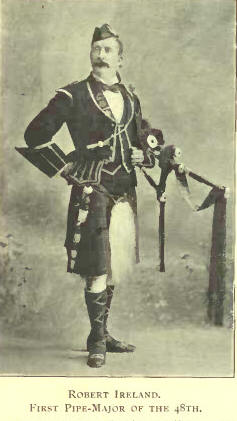
West Elgin Caledonian
Society, Dutton, Ont. In the bagpipe contests held by the North America
United Caledonian Assn., of whose committee he was long a member, he was a
prominent, and generally the leading competitor. As a composer of marches he
occupies a flatteringly high place. When Pipe-Major of the Forty-Eighth he
composed a march in honour of the Regiment, and named it "Lieut-Colonel John
I. Davidson," after the commanding officer of the battalion at that time.
The march is an exceedingly beautiful composition, but on account of the
delicate intricacy of the gracing and combinations, it is heard to better
effect, in the hands of -a good piper, when played as a slow march than in
marching time ; therefore, it has not become a popular tune on parade,
although as a practice tune it holds a high place in the estimation of the
lovers of the pipes. It is greatly admired in the Old Country, and just as
in some instances one song has made a poet famous, so this one tune has
raised Mr. Ireland to a niche in the piper s temple of fame. Other
compositions might be mentioned also, were they The writer, however
associated with the gallant Forty-Eighth, ever, may be pardoned if he makes
a single exception and acknowledges here Mr. Ireland s tune named after him,
which also has met with no small praise.
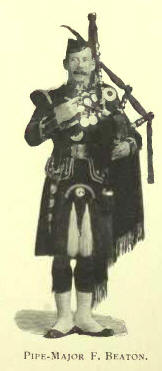 Following Mr. Ireland, the
pipe-majorship was held by Mr. Norman MacSwayed, a native of Dingwall,
who had a military training as a piper and who was a strict disciplinarian
and a thoroughly capable leader. He was known as a good piobaireachd player
in Scotland, and had won honours at Braemar, and other Highland gatherings
where were competitions for mastery in the music of Scotland. Mr. MacSwayed
had in his band : Sergeant George Murray, Pipers Wm. Currie, Hugh Mackenzie,
James R. Muir, John Sutherland, John Trenholm, George Thomson, James
Thomson, John Shire, and John Bryden; Drummers Alexander Munro, Samuel
McCracken, Harry McGowen, James Malbrough, Charles Hawkins, and George
Cottenden. Following Mr. Ireland, the
pipe-majorship was held by Mr. Norman MacSwayed, a native of Dingwall,
who had a military training as a piper and who was a strict disciplinarian
and a thoroughly capable leader. He was known as a good piobaireachd player
in Scotland, and had won honours at Braemar, and other Highland gatherings
where were competitions for mastery in the music of Scotland. Mr. MacSwayed
had in his band : Sergeant George Murray, Pipers Wm. Currie, Hugh Mackenzie,
James R. Muir, John Sutherland, John Trenholm, George Thomson, James
Thomson, John Shire, and John Bryden; Drummers Alexander Munro, Samuel
McCracken, Harry McGowen, James Malbrough, Charles Hawkins, and George
Cottenden.
When Mr. MacSwayed resigned
the position to return to Scotland, his place was filled by Mr. Farquhar
Beaton, who holds the office now. The pipers who have been and are in the
band during Mr. Beaton's term are: Sergeants George Murray, John Trenholm,
and Samuel Leask; Pipers Wm. Currie, George Thomson, James Thomson, Wm.
Johnson, Samuel McCracken, James Clunas, Joseph Halcro, James Craig, H.
Bourne, George Sutherland, Frank Ritchie, Gavin Hardy, Thomas Richardson,
Alexander Robertson, Charles Boney, Charles Currie, Archibald Ritchie, and
A. B. MacGillivray; Drummers Alexander Munro, Charles Hawkins, George
Cottenden, Wm. McCracken, J. Malbrough, Walter Ross, Harry Latremoville, and
Robert Murray. At the present time the strength of the band on parade is
twenty-three sixteen pipers and seven drummers but there are quite a number
under tuition, who do not rank on the strength of the band.
Pipe-Major Beaton has
maintained the efficiency of his pipe-band by indefatigable practice. There
are four practices every week, two for the beginners and two for the
advanced pipers. With the former great pains are taken. Besides the ordinary
scales Mr. Beaton has devised simple scales which explain those given in the
books, with the result that the music is simplified and made easier to the
learner. Attention is given to the capacity of each member of the class and
special exercises are given accordingly. Therein lies Mr. Beaton's success
as an instructor. He has introduced a new practice to his band, viz.,
playing the four parts, the melody, tenor, alto, and bass, of the tune at
the same time, on an orchestral basis, as has been the practice with some of
the Old Country regimental bands for many years, but hither to unknown in
Canada. This idea was developed from an incident worth recording. When His
Excellency, the Earl of Aberdeen, who is an ardent admirer of the bagpipes,
was publicly entertained in Toronto, prior to his departure from Canada on
the expiry of his term as Governor-General, the pipe band of the
Forty-Eighth was in attendance at the ceremonies (in the Parliament
Buildings). The Pipe-Major and one of the pipers played in concert the first
and second part of the tune "The Green Hills of Tyrol." The effect produced
was at once noted by His Excellency, who complimented the Pipe-Major
personally, and strongly recommended the cultivation of part-playing on the
pipes, which since then has been done.
Pipe-Major Beaton has played
the pipes since he has been fourteen years old, and has long been connected
with volunteer corps as a piper. He won the championship of Edinburgh in
1881 against fifteen competitors, of whom the late celebrated William
MacLennan was one. One of his most coveted honours is the Chicago World s
Fair championship and gold medal. In the circuit of Caledonian games in
Canada and the United States for the years 1895, 96. 97, he took every first
prize for which he competed, and he holds the first place for two of the
three years required for the championship trophy of the West Elgin
Caledonian Association. He is the able composer of quite a number of
marches, the most noted being "The Midlothian Amateur Pipe Band," published
by David Glen, Edinburgh; and the "North American Pipers Association March."
THE FORTY-EIGHTH BRASS BAND
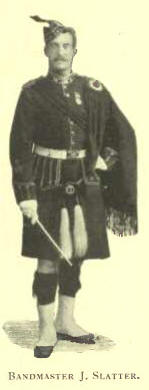 The Brass Band of the
Forty-Eighth Highlanders was organized in the fall of 1892. Mr. John
Griffin, a graduate of Kneller Hall Military School of Music, and Bandmaster
of H.M. 63rd Regiment, was selected, and appointed Bandmaster. Upon his
arrival in Toronto he began the formation of the first "kilted" brass band
in Canada. The Regiment purchased a complete set of band instruments,
uniforms, etc., costing in the neighborhood of $5,000. The Band paraded for
the first time with the Regiment in the spring of 1893, future purpose of
attending a church parade. From the very outset the Band became one of the
recognized bands in Canada, and played at some of the most important events. The Brass Band of the
Forty-Eighth Highlanders was organized in the fall of 1892. Mr. John
Griffin, a graduate of Kneller Hall Military School of Music, and Bandmaster
of H.M. 63rd Regiment, was selected, and appointed Bandmaster. Upon his
arrival in Toronto he began the formation of the first "kilted" brass band
in Canada. The Regiment purchased a complete set of band instruments,
uniforms, etc., costing in the neighborhood of $5,000. The Band paraded for
the first time with the Regiment in the spring of 1893, future purpose of
attending a church parade. From the very outset the Band became one of the
recognized bands in Canada, and played at some of the most important events.
The position of Bandmaster
becoming vacant in January, 1896, Mr. J. Slatter, the present Bandmaster,
was selected from a large number of applicants, and was appointed to fill
the vacancy. Mr. Slatter was formerly soloist in the famous 1st Life Guards
Band, of London, Eng., and later served with distinction in Brook s great
Marine Band. He is a successful composer and writer of band music. Under his
direction the Band at once took rank, and has been acknowledged for three
years as one of the best, if not the best, brass band in Canada. It has
grown to a strength of forty members, and the Regiment is naturally
extremely proud of it.
THE BUGLE BAND.
The Bugle Band was organized
at an early stage in the history of the Regiment, under Bugle-Major E.
Robertson, and soon attained to strength and excellence. Bugle-Major
Robertson was succeeded by Mr. J. Woods, also an excellent instructor and
manager. At the present the Bugle Band is disorganized, the Regiment trying
an experiment in the direction of further strengthening the Pipe and Brass
Bands instead of maintaining three.
THE SERGEANTS MESS
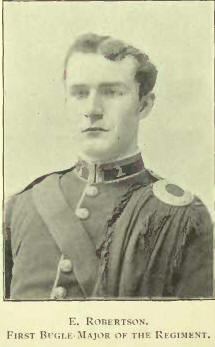 The Sergeants Mess is a most
important part of any military organization. That of the Forty-Eighth
Highlanders, it goes without saying, is no exception to the rule. The date
of its formation is the 4th of May, 1892, and the place No. 66 Elm Street,
the residence of the Sergeant-Major, Mr. Alfred G. Robertson.
Colour-Sergeant Hugh Rose acted as Secretary-Treasurer. The subsequent
meetings were held at the old Upper Canada College buildings, and until the
first annual meeting in January, 1893, the Mess was conducted by an
executive committee, consisting of Staff-Sergeant Harp, Staff-Sergeant
Hollinger, Colour-Sergeant George MacBean, Colour-Sergeant Rose, Sergeant
D.W. Smith, and the Sergeant-Major, with Sergeant Andrew Gordon Fraser as
Secretary-Treasurer of the Mess. On October I7th, 1892, the Mess moved into
quarters at old Upper Canada College. On the 9th of January, 1893, the
following officers and committees were elected: President, Staff-Sergeant
Wm. Harp; Vice-President, Colour-Sergeant Geo. MacBean, and later on,
Staff-Sergeant Rose; Secretary, Lance-Sergeant Arthur McEvoy; Treasurer,
Colour-Sergeant Hugh Rose. Committee: Colour-Sergeant Wm. Stewart, Sergeant
A. G. Fraser, and Sergeant Davidson. Librarian to the Mess, Sergeant A. G.
Fraser. The Sergeants Mess is a most
important part of any military organization. That of the Forty-Eighth
Highlanders, it goes without saying, is no exception to the rule. The date
of its formation is the 4th of May, 1892, and the place No. 66 Elm Street,
the residence of the Sergeant-Major, Mr. Alfred G. Robertson.
Colour-Sergeant Hugh Rose acted as Secretary-Treasurer. The subsequent
meetings were held at the old Upper Canada College buildings, and until the
first annual meeting in January, 1893, the Mess was conducted by an
executive committee, consisting of Staff-Sergeant Harp, Staff-Sergeant
Hollinger, Colour-Sergeant George MacBean, Colour-Sergeant Rose, Sergeant
D.W. Smith, and the Sergeant-Major, with Sergeant Andrew Gordon Fraser as
Secretary-Treasurer of the Mess. On October I7th, 1892, the Mess moved into
quarters at old Upper Canada College. On the 9th of January, 1893, the
following officers and committees were elected: President, Staff-Sergeant
Wm. Harp; Vice-President, Colour-Sergeant Geo. MacBean, and later on,
Staff-Sergeant Rose; Secretary, Lance-Sergeant Arthur McEvoy; Treasurer,
Colour-Sergeant Hugh Rose. Committee: Colour-Sergeant Wm. Stewart, Sergeant
A. G. Fraser, and Sergeant Davidson. Librarian to the Mess, Sergeant A. G.
Fraser.
The first annual dinner was
held on the 10th of March, 1893, in the Arlington Hotel, the Sergt.-Major
presiding. The guests included a large number of officers and non-coms, of
the neighbouring regiments and friends of the Forty-Eighth.
On the 27th of July, 1893, a
joint moonlight excursion with the Sergeants Mess of the 13th Battalion was
held to Oakville, the Toronto men going by the steamers "Garden City" and
"Greyhound."
The officers for the
succeeding years have been: 1894 President, Staff- Sergeant Harp;
Vice-President, Staff-Sergeant A. Rose; Secretary, Colour-Sergeant Neil
MacKinnon; Treasurer, Sergeant John Graham. Board of Management:
Colour-Sergeant Stewart, Colour-Sergeant Lawrence, and Sergeant Davidson.
1895 President, Staff-
Sergeant Harp; Vice-President, Staff-Sergeant A. Rose; Secretaries,
Colour-Sergeant Neil MacKinnon, and Sergeant Donald Morrison; Treasurer,
Sergeant John Graham. Board of Management : Colour-Sergeant Law rence,
Colour-Sergeant Smith, and Sergeant McEvoy.
1896 President,
Staff-Sergeant A. Rose; Vice-President, Colour-Sergeant Stewart ;
Secretaries, Sergeant D. Morrison, and Sergeant S. V. Jones; Treasurer,
Sergeant Cameron, Board of Management : Colour-Sergeant Wright, Colour-
Sergeant Shaw, and Sergeant C. McDonald.
1897 President, Colour
Sergeant Stewart; Vice-President, Sergeant Cameron; Secretary, Sergeant S.
V. Jones ; Treasurer, Lance-Sergeant Arch. Macgregor. Board of Management:
Sergeant Lambe, Sergeant Bruce, and Colour-Sergeant Richie.
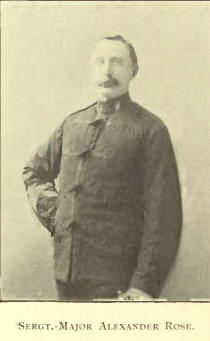 1898 President, Sergeant
Lambe; Vice-President, Colour-Sergeant Jones; Secretary, Colour-Sergeant
Grant; Treasurer, Lance-Sergeant Miller. Board of Management :
Colour-Sergeant Wallbridge, Sergeant Macgregor, Sergeant McRae. 1898 President, Sergeant
Lambe; Vice-President, Colour-Sergeant Jones; Secretary, Colour-Sergeant
Grant; Treasurer, Lance-Sergeant Miller. Board of Management :
Colour-Sergeant Wallbridge, Sergeant Macgregor, Sergeant McRae.
1899 President, Bugle-Major
Woods; Vice-President, Colour-Sergeant Macgregor; Secretaries, Sergeant W.
H. Grant, and J. H. Campbell; Treasurer, Sergeant E. N. May. Committee :
Sergeant Stewart, Colour-Sergeant Stevens, and Colour-Sergeant Rae.
1900 President, Bugle-Major Woods, until April 18th, and from that date
Sergeant Merry; Vice-President, Colour-Sergeant Rae; Secretary, Sergeant].
H. Campbell; Treasurer, Colour-Sergeant Kirkness. Board of Management :
Sergeant Miller, Hospital Sergeant Ross, and Colour-Sergeant Thorne.
The honorary members of the
Sergeants Mess are: Mr. Wm. Simpson, builder, Toronto, who took a deep
interest in the formation of the Regiment ; Mr. Alexander Muir. M A., author
of "The Maple Leaf," Canada's national song; Sergeant-Major Harding, and Mr.
Bert Harvey.
It is a rule of the Mess that
a handsome clock should be presented to each member who leaves the bachelors
ranks for those of the benedicts, and this rule has been ever
enthusiastically honoured.
Among the donations to the
Mess-room from friends is a fine marble clock, the gift of Mrs. Davidson,
wife of the first commanding officer of the Regiment, and many valuable
pictures from members and ex-members.
A function which is greatly
enjoyed is an annual rifle contest between picked teams, one representing
the Sergeants Mess and the other the Officers Mess.
Although some of the crack
shots of the Regiment are officers, the non-coms, have never failed so far
to win the trophy, which is a cup, to be held by the winning team for the
year.
 The main objects aimed at by
the Sergeants Mess are : to stimulate mutual interest in the efficiency and
welfare of the Regiment, and to cultivate and preserve friendly regard and
esteem amongst the members. Mess meetings are held on the second Monday of
each month, and during the winter season bowling is considerably indulged in
under the auspices of the Mess, winding up by a stirring tournament which
valuable prizes are offered. In the Mess-rooms there are first-class
illustrated papers and magazines for the use of the members, who find in the
Mess quarters a convenient rendezvous at which esprit dc corps and the
social side of volunteering can be pleasantly cultivated. The main objects aimed at by
the Sergeants Mess are : to stimulate mutual interest in the efficiency and
welfare of the Regiment, and to cultivate and preserve friendly regard and
esteem amongst the members. Mess meetings are held on the second Monday of
each month, and during the winter season bowling is considerably indulged in
under the auspices of the Mess, winding up by a stirring tournament which
valuable prizes are offered. In the Mess-rooms there are first-class
illustrated papers and magazines for the use of the members, who find in the
Mess quarters a convenient rendezvous at which esprit dc corps and the
social side of volunteering can be pleasantly cultivated.
The value of such a spirit
need not be enlarged upon. To it every military organization owes more than
can be told. Time and again this truth has been exemplified in the
experience of the Forty-Eighth Highlanders, whose non-commissioned officers
are enthusiastic soldiers, and thoroughly efficient in the positions they
occupy. It has been the good fortune of the regiment to be admirably
officered, and with equal emphasis this can be applied to the
non-commissioned officers, whose services have been conspicuous in
maintaining the excellent condition of the regiment. Without the Sergeant's
Mess this could not be done, for it is the home of the non-coms., the centre
of their activity, and the institution around which regimental memories will
the longest linger. |
